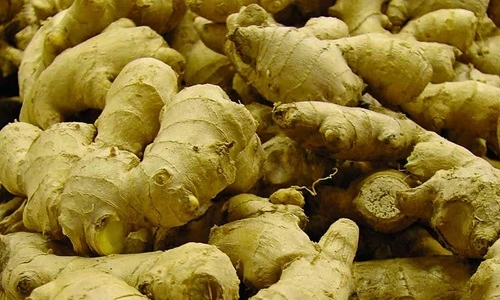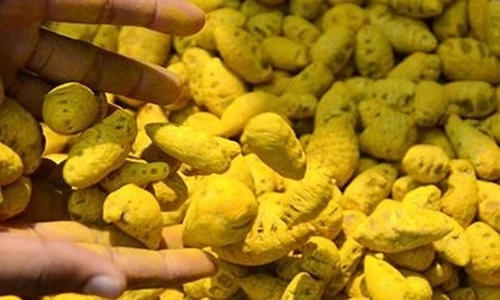Ginger, a widely cultivated spice crop, holds immense importance in Indian agriculture. Known for its pungent flavor and medicinal properties, ginger is used in cooking, beverages, and Ayurvedic medicine. India is the largest producer and exporter of ginger globally, accounting for a significant share of the world’s supply. Rich in antioxidants, gingerol, vitamins, and minerals, ginger is valued for its anti-inflammatory, digestive, and therapeutic benefits.
Ginger thrives in warm and humid climates, with regions receiving abundant rainfall and well-drained soils being ideal for cultivation. States like Kerala, Karnataka, Assam, Meghalaya, West Bengal, Odisha, Maharashtra, and Andhra Pradesh are major ginger producers in India.
This article highlights more than 10 top ginger varieties cultivated in India, detailing their characteristics, regions, and suitability for various uses such as fresh consumption, processing, and export.

1. Nadia
Nadia is a high-yielding variety widely grown in northeastern India and West Bengal.
- Rhizome Size: Large, bold
- Color: Light brown skin, pale yellow flesh
- Fiber Content: Moderate
- Regions: West Bengal, Odisha, Assam, Meghalaya
- Characteristics:
- High yield and good adaptability to heavy rainfall areas
- Excellent for fresh markets and processing
- Uses: Fresh consumption, dry ginger, and oil extraction
2. IISR Varada
IISR Varada is a popular variety developed by the Indian Institute of Spices Research (IISR) for high yield and disease resistance.
- Rhizome Size: Medium to large
- Color: Light brown skin, cream-colored flesh
- Fiber Content: Low
- Regions: Kerala, Karnataka, Tamil Nadu
- Characteristics:
- High resistance to rhizome rot and bacterial wilt
- Early-maturing variety with good yield potential
- Uses: Fresh ginger, processing, and export
3. Rio-de-Janeiro
Rio-de-Janeiro is a commercially important variety known for its bold rhizomes and high yield.
- Rhizome Size: Large and bold
- Color: Brown skin, yellowish-white flesh
- Fiber Content: Moderate
- Regions: Karnataka, Maharashtra, Kerala
- Characteristics:
- High yielding and tolerant to various climatic conditions
- Suitable for fresh and dried ginger
- Uses: Processing, fresh markets, and ginger oil
4. Suprabha
Suprabha is a widely cultivated variety with large rhizomes and good disease resistance.
- Rhizome Size: Medium to large
- Color: Pale yellow skin and flesh
- Fiber Content: Low
- Regions: Odisha, West Bengal, Assam
- Characteristics:
- High resistance to pests and diseases
- Consistent yield under humid climates
- Uses: Fresh markets, dry ginger
5. Maran
Maran is a traditional ginger variety grown extensively in Tamil Nadu for its distinct flavor and size.
- Rhizome Size: Medium
- Color: Dark brown skin, yellow flesh
- Fiber Content: High
- Regions: Tamil Nadu, Kerala
- Characteristics:
- Popular for its strong aroma and flavor
- Suitable for fresh and dry ginger production
- Uses: Culinary uses, dried ginger
6. Himachal Pradesh Local (Himachali Ginger)
This variety is well-adapted to the cool climatic conditions of the Himalayan regions.
- Rhizome Size: Medium
- Color: Brownish skin, cream-colored flesh
- Fiber Content: Moderate
- Regions: Himachal Pradesh, Uttarakhand
- Characteristics:
- Strong aroma and spiciness
- Good resistance to rhizome rot
- Uses: Fresh consumption, traditional medicine
7. Karthika
Karthika is a high-yielding variety known for its bold rhizomes and excellent quality.
- Rhizome Size: Large
- Color: Pale skin, cream-colored flesh
- Fiber Content: Low
- Regions: Kerala, Karnataka, Maharashtra
- Characteristics:
- High yield potential and early maturity
- Suitable for organic farming
- Uses: Fresh ginger, processing, and powder production
8. Athira
Athira is an improved variety with high yield and resistance to major diseases.
- Rhizome Size: Medium to large
- Color: Light brown skin, pale yellow flesh
- Fiber Content: Low
- Regions: Kerala, Tamil Nadu, Karnataka
- Characteristics:
- Tolerant to rhizome rot and pest infestations
- Consistent yield with strong flavor
- Uses: Culinary, ginger oil, and processing
9. Assam Local
Assam Local is a popular variety grown extensively in the northeastern regions of India.
- Rhizome Size: Small to medium
- Color: Dark brown skin, yellowish flesh
- Fiber Content: Moderate
- Regions: Assam, Meghalaya, Nagaland
- Characteristics:
- Highly aromatic with a strong pungent flavor
- Thrives in humid, tropical conditions
- Uses: Fresh consumption, dried ginger
10. Wynad Local
Wynad Local is a native variety grown in Kerala’s Wayanad district with excellent culinary value.
- Rhizome Size: Medium
- Color: Brown skin, yellow flesh
- Fiber Content: Moderate
- Regions: Kerala
- Characteristics:
- High market demand due to its rich aroma
- Tolerates humid climates
- Uses: Fresh consumption, spice markets
11. Mahima
Mahima is an improved variety developed for high yields and excellent processing quality.
- Rhizome Size: Large
- Color: Light brown skin, cream-colored flesh
- Fiber Content: Low
- Regions: Karnataka, Kerala, Tamil Nadu
- Characteristics:
- High yield with bold rhizomes
- Suitable for processing into powder and oil
- Uses: Fresh consumption, ginger powder, and oil
FAQs
Q1: Which ginger variety is best for fresh consumption?
A: Nadia, Rio-de-Janeiro, and IISR Varada are excellent for fresh consumption due to their bold rhizomes and strong flavor.
Q2: Which ginger variety has high resistance to diseases?
A: IISR Varada and Athira are highly resistant to rhizome rot and bacterial wilt.
Q3: Which state is the largest producer of ginger in India?
A: Kerala is the largest producer of ginger, followed by Karnataka and the northeastern states.
Q4: Which variety is ideal for dry ginger production?
A: Maran, Assam Local, and Suprabha are preferred for dry ginger production due to their fibrous nature.
Q5: Can ginger be grown in hilly regions?
A: Yes, varieties like Himachali Ginger and Assam Local are suitable for cultivation in hilly and cool regions.
India’s diverse climatic zones and innovative agricultural research have made it possible to cultivate high-yielding, disease-resistant, and region-specific ginger varieties like Nadia, IISR Varada, Rio-de-Janeiro, and Mahima. By selecting the appropriate variety and adopting proper cultivation practices, farmers can achieve higher yields, better profits, and contribute to India’s dominance in the global ginger market.

